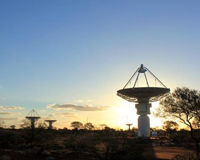Bye bye, BETA
|
|
29 February 2016
In what is a bittersweet milestone for the ASKAP project, the Boolardy Engineering Test Array – or BETA, as it is known – has officially been decommissioned at the Murchison Radio-astronomy Observatory in Western Australia.
In order to make way for installation of ASKAP’s new receiver systems, BETA’s digital backend equipment was removed from the screened room of the MRO Control Building, officially marking the end of its time as an operational system on the ASKAP antennas.
BETA represented the first six ASKAP antennas installed with first generation (Mk I) phased array feed receiver systems. Originally intended as a commissioning instrument used by the engineering team to prepare for the full fit-out of the ASKAP telescope, initial data proved itself to be scientifically valuable to preparing for commissioning activities and early science demonstration projects.
Some of BETA’s published results include the discovery of HI absorption in a galaxy billions of light years away, the first large-scale map of HI emission over six square degrees, and confirmation of intermittent pulsar theories.
These results were a ‘proof of concept’ for ASKAP and would not have been possible without the unique features of the telescope, namely a wide field of view, rapid survey capability, as well as the radio-quiet environment of the MRO. But it is not the end of discovery yet – data processing will continue and further discoveries will be made, especially through open access to BETA demonstration data.
BETA allowed the ASKAP team to showcase the impact that PAFs will have on radio astronomy – something recognised by colleagues in engineering, innovation and scientific communities as it collected awards three years in a row.
“This has been an incredibly important instrument,” said Ant Schinckel, ASKAP Project Director, “BETA was essential in demonstrating how well PAFs work in an interferometer, and also how suited they are for radio astronomy. The importance of BETA will be realised in coming years, especially as other radio telescopes consider PAFs for their facilities.”
The sentiment was echoed by Suzy Jackson, ASKAP engineer at the MRO, who said, “BETA lived up to its name, an engineering test array. We learned an enormous amount about how to operate a synthesis telescope with PAFs, and it gave us a whiff of future science the full ASKAP telescope will be able to do.”
The removal of the BETA systems from the MRO Control Building now makes room for the digital backends of the next batch of Mk II PAFs, enabling commissioning of ASKAP-12 and the start of ASKAP Early Science.
“I want to extend my personal thanks to the whole team,” continued Ant, “Everyone had a hand in the development of BETA through funding, designing, deploying, debugging, maintaining, and understanding the instrument as a fully functioning telescope. These lessons will make working with the Mk II PAFs much easier!”
Back to Latest ASKAP News page.

